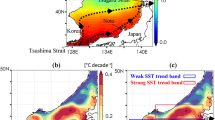Abstract
Variation in intermediate water salinity in the South China Sea (SCS) between the 1960s and 1980s was studied using historical hydrographic data. The results demonstrate that the water was significantly fresher in the 1980s than in the 1960s, indicating that vertical mixing at intermediate water depth was reduced in the 1980s. This was partially because of the change of the SCS meridional overturning circulation (MOC) connecting local intermediate water with deep water. Data assimilation showed a 0.5 Sv (1 Sv=106 m3 /s) reduction in the strength of the MOC, which is about one third of the mean SCS MOC. Because the SCS MOC is linked to the Pacific Ocean, such an interdecadal variation in the intermediate water SCS may reflect anthropogenic climate change in the world ocean.
Similar content being viewed by others
References
Auad G, Kennrtt J P, Miller A J. 2003. North Pacific intermediate water response to a modern climate warming shift. Geophy. Res. Lett., 108(C11): 1–8.
Broecker W, Patzert W, Toggweiler J, Stuive M. 1986. Hydrography, chemistry, and radioisotopes in the southeast Asian basins. J. Geophys. Res., 91: 14 345–14 354.
Carton J A, Giese B S. 2008. SODA: a reanalysis of ocean climate using simple ocean data assimilation (SODA). Monthly Weather Review, 136: 2 999–3 017.
Gamo T, Momoshima N, Tolmachyov S. 2001. Recent upward shift of the deep convection system in the Japan Sea, as inferred from the geochemical tracers tritium, oxygen, and nutrients. Geophy. Res. Lett., 28(21): 4 143–4 146.
Gille S T. 2002. Warming of the Southern Ocean since the 1950s. Science, 416: 832–837.
Huang R X, Wang W, Liu L L. 2006. Decadal variability of wind-energy input to the world ocean. Deep Sea Res. II, 53: 31–41.
Kim K, Kim K R, Min D H et al. 2001. Warming and structural changes in the East (Japan) Sea: a clue to future changes in global oceans? Geophy. Res. Lett., 28(17): 3 293–3 296.
Levitus S, Antonov J, Wang J, Delworth T L, Dixon K W, Broccoli A J. 2001. Anthropogenic warming of Earth’s climate system. Science, 292: 267–230.
Li L, Qu T. 2006. Thermohaline circulation in the deep South China Sea basin inferred from oxygen distributions. J. Geophys. Res., 111: C05017, http://dx.doi.org/10.1029/2005JC003164.
Qu T. 2002. Evidence for water exchange between the South China Sea and the Pacific Ocean through the Luzon Strait. Acta Oceanol. Sin., 21: 175 185.
Qu T, Kim Y Y, Yaremchuk M et al. 2004. Can Luzon Strait transport play a role in conveying the impact of ENSO to the South China Sea? J. Climate, 17: 3 644–3 657.
Qu T, James B, Whitehead J. 2006. Deepwater overflow through Luzon Strait. J. Geophys. Res., 111: C01002, http://dx.doi.org/10.1029/2005JC003139.
Qu T, Mitsudera H, Yamagata T. 1999. A climatology of the circulation and water mass distribution near the Philippine coast. J. Phys. Oceanogr., 29: 1 488–1 505.
Qu T, Mitsudera H, Yamagata T. 2000. Intrusion of the North Pacific waters into the South China Sea. J. Geophys. Res., 10 5(C3): 6 415–6 424.
Rahmstorf S. 1995. Bifurcations of the Atlantic thermohaline circulation in response to changes in the hydrological cycle. Nature, 378: 145–149.
Wang D, Liu X B, Wang W Z et al. 2004. Simulation of meridional overturning in the upper layer of the South China Sea with an idealized bottom topography. Chin. Sci. Bull., 49(7): 740–747.
Wong A P S, Bindoff N L, Church J A. 1999. Large-scale freshening of intermediate waters in the Pacific and Indian Oceans. Nature, 400: 440–443.
Wood R A, Keen A B, Mitchell J F B, Gregory J M. 1999. Changing spatial structure of the thermohaline circulation in response to atmospheric CO2 forcing in a climate model. Nature, 399: 572–575.
Yuan D. 2002. A numerical study of the South China Sea deep circulation and its relation to the Luzon Strait transport. Acta Oceanol. Sin., 21(2): 187–202.
Author information
Authors and Affiliations
Corresponding author
Additional information
Supported by the National Basic Research Program of China (973 Program) (No. 2011CB403504), the Knowledge Innovation Program of Chinese Academy of Sciences (No. KZCX2-YW-Q11-02), and the National Natural Science Foundation of China (No. 40806003)
Rights and permissions
About this article
Cite this article
Liu, C., Wang, D., Chen, J. et al. Freshening of the intermediate water of the South China Sea between the 1960s and the 1980s. Chin. J. Ocean. Limnol. 30, 1010–1015 (2012). https://doi.org/10.1007/s00343-012-1280-y
Received:
Accepted:
Published:
Issue Date:
DOI: https://doi.org/10.1007/s00343-012-1280-y




